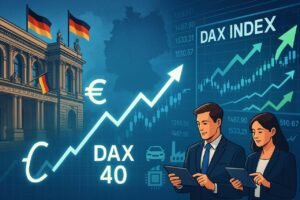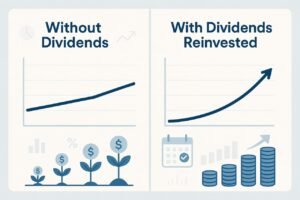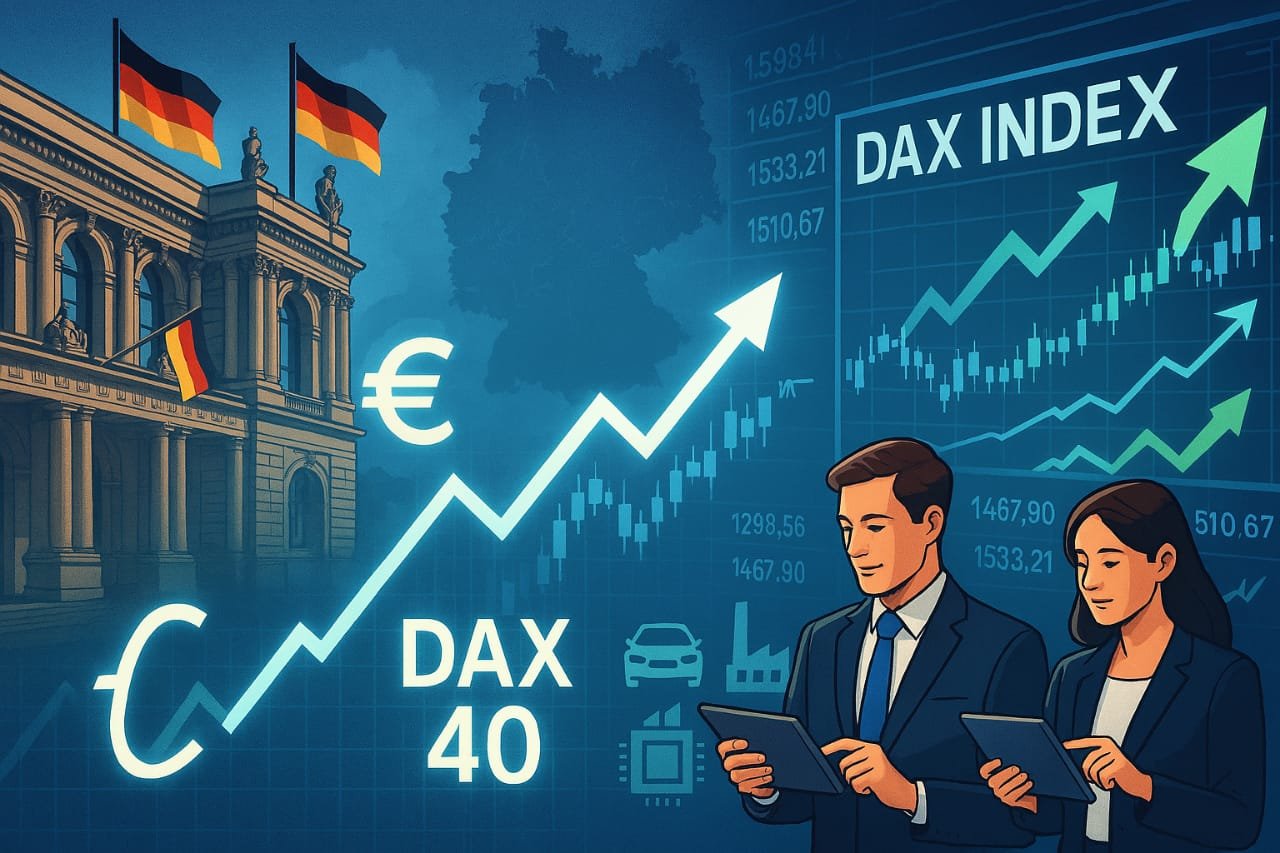DAX Index: Germany’s Market Powerhouse & What Investors Should Know
When people think of major global stock indices, names like the S&P 500 or the FTSE 100 may come to mind first. But if you’re overlooking the DAX Index, you’re missing out on one of Europe’s most powerful financial benchmarks. The DAX isn’t just Germany’s most important index—it’s a real-time reflection of Europe’s largest economy and a crucial indicator for global markets.

In this deep dive, we’ll explore what the DAX Index is, how it works, how it compares to global indices, why it matters to investors, and how you can benefit from tracking it closely.
🔍 What Is the DAX Index?
The DAX Index, short for Deutscher Aktienindex, tracks the performance of the 40 largest and most liquid companies listed on the Frankfurt Stock Exchange. These firms are selected based on market capitalization and order book volume, ensuring that the DAX is a precise barometer of the German economy.
You can view the live composition and performance details of the index on the official Deutsche Börse DAX Index page — the primary source for DAX data and methodology.
Key Facts About the DAX:
| Feature | Details |
|---|---|
| Launch Year | 1988 |
| Number of Constituents | 40 (expanded from 30 in 2021 for better market representation) |
| Exchange | Frankfurt Stock Exchange (Xetra system) |
| Weighting Method | Free-float market capitalization |
| Update Frequency | Every second during trading hours (real-time) |
🇩🇪 Why the DAX Index Matters Globally
Germany isn’t just the largest economy in Europe—it’s the fourth-largest in the world. This means that the performance of its top companies has a ripple effect far beyond its borders. The DAX Index is therefore not only a snapshot of German industry but also a proxy for European economic health.
From household names like Siemens, SAP, BMW, and Allianz, the DAX includes companies that are:
-
Global exporters
-
Leaders in automotive, software, chemicals, and finance
-
Influential players in ESG and green technologies
Example: When SAP experiences a strong quarter, it often influences technology stocks across European indices and can even impact investor confidence in tech globally.
📊 DAX Index vs Global Indices: How Does It Compare?
To understand the uniqueness of the DAX, let’s compare it with other major indices.
| Index | Region | No. of Stocks | Weighting | Notable Sectors |
|---|---|---|---|---|
| DAX | Germany | 40 | Free-float Market Cap | Industrials, Auto, Software |
| S&P 500 | U.S. | 500 | Market Cap | Tech, Healthcare, Finance |
| FTSE 100 | UK | 100 | Market Cap | Energy, Finance, Consumer Goods |
| Nikkei 225 | Japan | 225 | Price-weighted | Tech, Industrial, Automotive |
Key Differences:
-
More industrially driven than the S&P 500
-
Less tech-heavy than the Nasdaq 100
-
Highly export-sensitive, making it more susceptible to global trade dynamics
💡 Unique Characteristics & Insights About the DAX Index
1. Dividends Included in Performance
Unlike many other indices, the DAX is a total return index. This means it assumes dividends are reinvested, offering a more complete picture of investor returns.

This feature makes historical DAX performance appear more impressive than indices that exclude dividends.
2. Currency Risk for International Investors
Since the DAX is euro-denominated, non-Euro investors (like those from the U.S. or UK) must consider exchange rate risks. A strong or weak euro can significantly impact returns.
3. ESG & Sustainability Trends
Germany has been at the forefront of sustainability initiatives, and many DAX-listed companies are leaders in green energy, carbon neutrality, and ESG investing. This gives the DAX an edge with ESG-conscious investors.
“Investors are increasingly looking at the DAX not just for growth, but for sustainable, responsible investing opportunities.” — Deutsche Börse Insights
4. High Volatility in Global Crises
Because many DAX companies are export-driven, global events (e.g., China’s slowdown, Ukraine war, U.S. inflation spikes) tend to hit the DAX harder and faster than domestically-focused indices.
🧠 How to Invest in the DAX Index
Investing in the DAX doesn’t mean you need to trade on the Frankfurt Exchange directly. There are multiple ways to gain exposure:
✅ DAX ETFs (Exchange-Traded Funds)
Some popular ETFs that track the DAX:
-
iShares Core DAX UCITS ETF
-
Lyxor DAX (DR) UCITS ETF
-
Xtrackers DAX UCITS ETF
These are available on international platforms and offer low fees, liquidity, and diversification.
✅ DAX Futures & Derivatives
If you’re an advanced trader, you can trade DAX Futures through Eurex, which offers high leverage and tight spreads.
✅ Global Mutual Funds
Several international mutual funds include DAX-heavy exposure under their European Equity umbrellas.
🧭 Key Trends Shaping the Future of the DAX Index
📈 Digital Transformation
Firms like SAP, Siemens, and Deutsche Telekom are spearheading Germany’s digital push. The DAX is increasingly representing this shift, making it attractive to long-term investors betting on digitization.
♻️ Green Economy Integration
Germany’s commitment to net-zero targets by 2045 is driving DAX constituents to innovate in renewables, EVs, and sustainable finance.
🧩 DAX Expansion from 30 to 40
In 2021, the index expanded from 30 to 40 companies, aiming for better sector representation and stability. This aligns it more closely with global standards and has reduced volatility while improving diversification.
📉 Risks to Consider When Tracking the DAX Index
No investment is without risk, and the DAX has its own set:
-
Export Dependence: A slowdown in global trade or tariffs can hit DAX constituents hard.
-
Currency Risk: As mentioned, euro fluctuations impact returns for non-EU investors.
-
Regulatory Pressure: EU regulations around ESG, taxation, and corporate responsibility may pose compliance challenges for companies.
-
Sector Bias: The DAX lacks diversity in tech compared to the U.S., potentially reducing growth in a tech-led bull market.
📌 My Perspective: Why I Track the DAX
As someone who has tracked global markets for years, the DAX Index always strikes me as underrated.
It offers:
-
Solid dividend-paying stocks
-
Strong industrial backbone
-
ESG-focused innovation
What makes the DAX particularly interesting is its blend of tradition and transformation. While it’s rooted in legacy industries like automobiles and chemicals, its members are quickly evolving through digital and sustainable strategies. For long-term investors, that’s a rare and valuable mix.
📣 Conclusion: Is the DAX Index Right for You?
If you’re a globally-minded investor seeking diversification beyond U.S. markets, the DAX Index is a compelling option. Its composition, dividend reinvestment approach, and alignment with Europe’s economic core make it a smart addition to any international portfolio.

Whether you invest directly through ETFs, monitor it for global cues, or analyze it for macroeconomic trends, understanding the DAX can deepen your market perspective.
✅ Final Call to Action
Want to explore more about global stock indices, investing tips, and market strategies?
👉 Subscribe to our newsletter for weekly insights, or check out our deep dives on the FTSE 100, S&P 500, and Nikkei 225.
And if you have thoughts or questions about the DAX Index, drop them in the comments below—let’s start a conversation!
